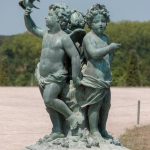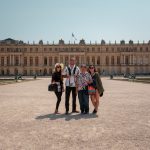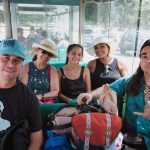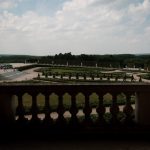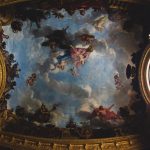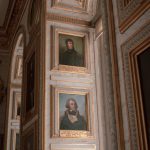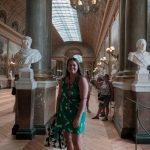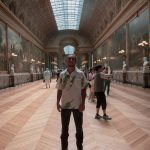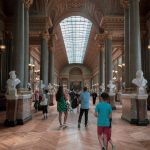by Kamuela Park, UG Student, Hawaiian Studies & Political Science & Wyatt Souza, PhD Student, English
Today, marking our second day in Palisa, we ventured out to Versailles to visit Chateau de Versailles (Palace of Versailles), which like our own ʻIolani Palace, originally symbolized the center of a monarchy while simultaneously used as a statement of power and influence to the rest of the world. As we entered on to the grounds of the palace, the gold plated gates and trims of the building immediately boasted a sense of luxury and grandeur, as did the vast and beautiful gardens which we visited first. At first glance, the gardens and palace does seem to be immense in size, but one cannot really fathom its obscene magnitude until it is actually traveled through. Even when we took a driving tour around the grounds on a mini train, we only saw a fraction of its nearly two thousand acres.
The palace was incredible, but it was also ridiculous. To imagine the amount of time and resources that it took to make this building, which spans over sixteen and a half acres, and includes more than 700 rooms that are filled with gold plated trims, railings, crystal chandeliers, marble sculptures and pillars, and paintings that occupy the entire space of the walls and ceilings, could be considered excessive to say the least. In many ways, it is an obvious example of this European imperial power flexing its colonial might.
We added Versailles to the itinerary because in our pre-trip research and class preparations, we learned about the different Hawaiian ali‘i who visited in the 1800s, including Alexander Liholiho (KIV) and Lot Kapuāiwa (KV) accompanied by Dr. G.P. Judd in 1850. The two young princes were only 15 and 18 at the time, and each kept a journal of their entire European and American trip (KIV’s journal was published by Hawaiian Historical Society, and KV’s journal is at Bishop Museum Archives). Before we departed for Europe, we went to the Bishop Museum Archives and saw some of the original ali‘i European travel journals there and pictures they had taken while abroad.
In reflecting he and his brothers (Lot Kapuāiwa) time at Versailles, Alexander Liholiho, in his journal, details in great length what they both witnessed and experienced during their visit to the palace. Liholiho recalls their March 27, 1850 visit through primarily describing the immense amount of paintings housed in Versailles. Liholiho writes, “The paintings I think were the best I have seen. It would take volumes to trace our steps from the time we entered to the palace till we went out, but suffice it to say the whole of the palais was composed of just such rooms, all full of paintings.” Liholiho continues in his journal to recall specific paintings throughout the palace that stand out to him, specifically focusing on the paintings of members of Frances royal family.
As we read through Liholiho’s reflection of his time at Versailles, we began to think of our own experiences in the palace and how, perhaps, our experiences may have, to varying degrees, paralleled that of these two young aliʻi. During our time at Versailles, many of us commented on the sheer extravagance of the palace, also noting the almost overwhelmingly amount of paintings housed there. After we finished our tour, we were left in deep thought and with many questions about the palace itself and, furthermore, the experiences our aliʻi had at Versailles.
While Liholiho documents he and Lots’ 1850 visit to the palace, his journal does not contain their overall intentions at the palace nor the major takeaways they may have had. We wondered about how much historical context did these two aliʻi have prior to their visit? What, perhaps, did they hope to take away or accomplish from their visit? What did they think about being at the site of the French revolution? What did they plan to take home and share with Hawaiʻi? We also stopped to ask ourselves what our intentions at Versailles was and, most importantly, what do we plan to take away from this experience abroad and share with Hawaiʻi? What stories will we tell?
Photo Credits: Anianikū Chong


















